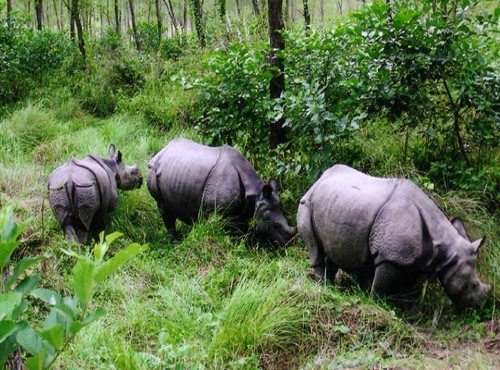Nature and Wildlife Tour in Nepal
Chitwan District lies in the southwest part of Province No. Bharatpur is the district's headquarters and Nepal's fifth-largest city. The district covers a total area of 2,238.39 km2. Chitwan Jungle Safari Tour, the most popular tourist activity in Chitwan, is considered the best. The Chitwan National Park is the first National Park in Nepal. It covers an area of 932 km2 and ranges from 100 m in river valleys up to 815m in the Churia Hills. The Park is home to 68 mammals, 56 species of herpetofauna, and 126 fish species. The Park is known for its one-horned crocodiles, royal Bengal Tigers, and gharial Crocodiles. The Park is home to the largest terrestrial mammal in the world (the wild elephant) and the smallest (the pygmy shhrew). There are 544 bird species recorded, including 22 globally endangered species, such as the Bengal Florican and Slender-billed Vulture.
Elephant Back Safari is included in the Chitwan National Park Safari Tour. You can explore subtropical forests and encounter endangered Royal Bengal Tigers and one-horned Rhinos. Chitwan Jungle Safari includes jungle walks, bird-watching, boating/canoeing, and elephant breeding.
The jungle safari is one of Nepal's most exciting trips, especially for those who want to see the variety of endangered birds and animals. This is because the Jungle of Nepal houses many species of birds and other animals close to extinction. Nearly 20% of the total land area is protected by various titles. The jungle is divided into four wildlife reserves, three conservation areas, and nine national parks.
You will be amazed by the beauty of nature in any area, whether the mountains, hills, or Terai (the plains land that borders India in the south belt). Terai is the country's southern belt and a rich habitat for birds and animals. There are many species to choose from, including the royal Bengal tiger, blue bull, crocodile, gharial, and blackbuck. If you visit the hilly regions, you'll be amazed by the beauty of the jungle, full of wildlife and birds, such as the red panda and other endangered species.
Climate
Each season offers a different experience. Enjoyable temperatures are available from October to February, with an average temperature of 25oC. Temperatures can reach 43oC from March to June. The humid, hot days are followed by the monsoons that last from late June to September. The rivers flood and the roads become impassable.
Local villagers may cut the thatch grasses in late January to meet their needs. This will allow visitors to see more wildlife. Between September and November and between February and April, the migratory bird population joins with the resident birds to create a spectacular bird-watching opportunity. The monsoons may bring lush vegetation, but most trees bloom in the late winter. Palash, also known as "the flame of the forest", and silk cotton trees have crimson-colored flowers visible from afar.
Chitwan National Park is characterized by tropical monsoon weather, with high elevations all year round and four seasons.
Summer
The traditional hot months are from early March to mid-June, with temperatures gradually increasing to a maximum in May. Even though April is hot during the day, it can get cold at night. In March, southwesterly winds are predominant, and the relative humidity is at its lowest.
Monsoon
At the end of the month, storms that precede the monsoon arrive. Dark clouds gather in the afternoons with high winds, thunder and lightning. Rain usually falls in the late afternoon and lasts only 15 to 20 minutes. Showers become more frequent as May turns into June.
Around the middle of the month, the real monsoon begins. The moisture-laden winds blowing up from the Bay of Bengal, bringing heavy rains, continue until late September. Of the 80-inch annual rainfall, over 80 percent falls during these three months.
In a monsoon, precipitation is only sometimes continuous. There are often as many days with no rain as there are with rain. During the rainy season, humidity levels are extremely high.
Winter
Winter is from October until the end of February. This is the best month to view the Great Himalayan Range because the northerly wind blows cool and comes down from the mountains. The air is especially clear in November.
The coldest month is January, when temperatures fall to almost freezing point, especially if it rains. The relative humidity reaches 100 percent in the mornings from late November. This causes dew to fall during the nights of December and January. It isn't easy to imagine that the temperature can rise to 20-25 Celsius by the afternoon. after a particularly cold morning





